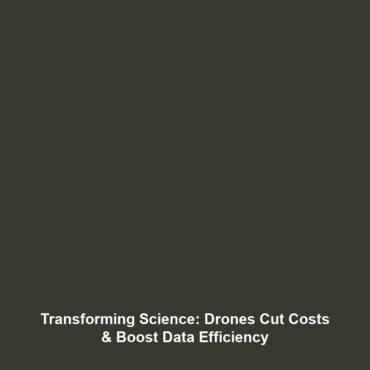Reduced Costs and Improved Data Collection Efficiency with Drones in Science
Drones have emerged as a transformative technology in science, enabling researchers to drastically reduce costs and enhance data collection efficiency compared to traditional methods such as satellites and manned aircraft. This innovation is significant in various fields, including environmental monitoring, agriculture, and wildlife conservation. With their ability to access hard-to-reach areas and collect data at unprecedented rates, drones are revolutionizing scientific methodologies, making research more efficient and accessible.
Key Concepts
The integration of drones into scientific research revolves around several key principles:
- Cost Efficiency: Drones require less funding than traditional aircraft or satellite systems, allowing researchers to allocate resources more effectively.
- Enhanced Data Collection: Equipped with advanced sensors, drones can collect high-resolution data quickly and at smaller scales, which is often difficult for larger aircraft.
- Accessibility: Drones can reach areas that are either unsafe or impossible for conventional methods, providing vital data from diverse environments.
These concepts emphasize the role of drones in science, showcasing their potential to provide more robust data while minimizing costs.
Applications and Real-World Uses
The applications of drones in science highlight their effectiveness in numerous fields:
- Environmental Monitoring: Drones are used to assess natural disaster impacts, track wildlife migration, and map vegetation for ecological studies.
- Agriculture: Precision agriculture employs drones for crop monitoring, allowing farmers to optimize yield while minimizing resource use.
- Archaeology: Researchers utilize drones to survey landscapes and uncover ancient sites without disturbing the ground, providing aerial perspectives and enhanced documentation.
These examples illustrate how the advantages of drones lead to innovative solutions and practices in scientific research.
Current Challenges
Despite their numerous benefits, the integration of drones in scientific research faces several challenges:
- 📌 Regulatory Hurdles: Strict regulations can limit drone operations and their potential academic and commercial uses.
- 📌 Data Security: Ensuring the security of collected data remains a persistent issue.
- 📌 Technical Limitations: Challenges in battery life, payload capacity, and sensor reliability can hinder efficiency.
Addressing these challenges is crucial for maximizing the benefits of drones in scientific applications.
Future Research and Innovations
The future of drones in science promises exciting innovations:
- Advanced AI Integration: Ongoing research is focusing on AI to enhance data analysis, improving decision-making processes based on drone-collected data.
- Next-Generation Sensors: Innovations in sensor technologies are expected to enhance the precision and type of data that can be collected through drones.
- Extended Range Capabilities: Enhancements in battery technology may lead to longer flight times and the ability to cover greater distances.
These developments are poised to further elevate the efficiency and effectiveness of drones in scientific research, enhancing their role as vital tools.
Conclusion
In summary, drones are not just simplifying data collection but also providing significant cost savings when compared to traditional methods like satellites and manned aircraft. As advancements in technology continue to emerge, the use of drones in scientific research will only grow, offering new opportunities for exploration and discovery. For further insights on related topics, consider exploring our sections on Environmental Monitoring and Precision Agriculture.
